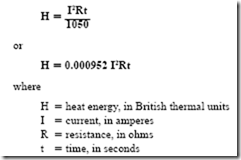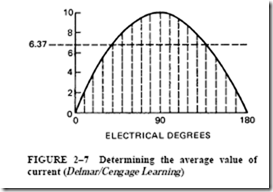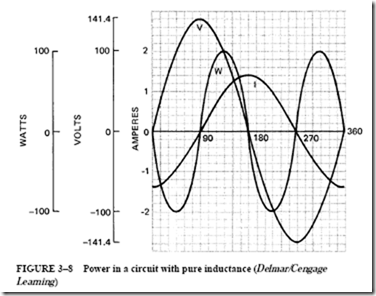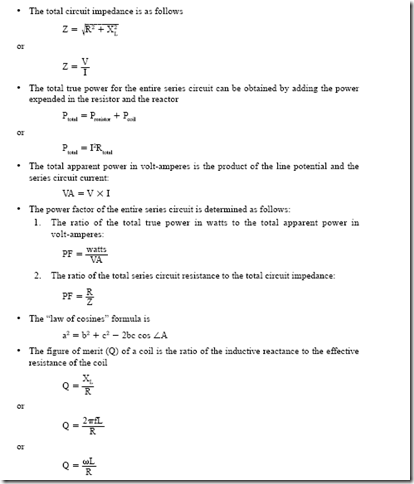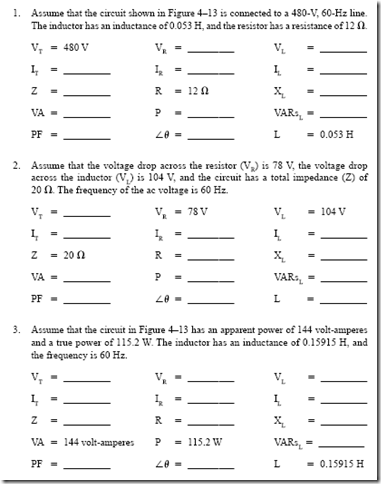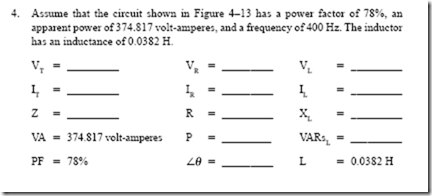POWER IN WATTS
In dc circuits, the power in watts is equal to the product of volts and amperes. For ac circuits, the power in watts at any instant is equal to the product of the volts and amperes at that same instant. However, the average power of ac circuits is not always the product of the effective values of the voltage and current. Because many of the loads supplied by ac circuits have inductive effects, such as motors, transformers, and similar equipment, the current is out of phase with the voltage. As a result, the actual power in watts is less than the product of the voltage and current.
When the current and voltage are in phase in an ac circuit, the average power for a complete cycle is equal to the product of the RMS voltage and the RMS current. In the noninductive circuit shown in Figure 2–1, an ac generator supplies a sine wave of voltage. This voltage has a maximum value of 141.4 V and is applied across the terminals of the 100-D noninductive heating element. The sine wave of current for this circuit is in phase with the voltage sine wave. The maximum current is 1.414 A.
Watts are often called true power in ac circuits. Electricity is a form of pure energy, and in accord with physical laws, energy cannot be created or destroyed, but its form can be changed. Watts is a measure of the amount of electrical energy converted into some other form. In the case of a heating element, it measures the amount of electrical energy converted into thermal energy. In the case of a motor, it is a measure of the amount of energy converted into kinetic energy.
Plotting a Power Curve
It was stated previously that the power at any instant is equal to the product of the volts and amperes at that instant. If the product of the instantaneous values of voltage and current is obtained at fixed increments of electrical time degrees, a power curve can be plotted. Table 2–2 lists the instantaneous values of voltage, current, and power in watts for 15° intervals from 0° to 360°, or one cycle.
Figure 2–6 shows the voltage and current sine waves and the power curve plotted from the data given in Table 2–2. The power curve, indicated by “W” in Figure 2–6, gives the instantaneous power in the circuit at any point in the 360° time period of one cycle.
The Power Curve. It can be seen that all points on the power curve in Figure 2–6 are positive for this ac circuit. During the first alternation of the cycle, both the current and the voltage are positive. As a result, the power curve is also positive. During the second alternation of the cycle, both the current and the voltage are negative. However, the power curve is still positive because the power is the product of a negative current and a negative voltage. The power curve is represented above zero in a positive direction. This means that the load is taking power (in watts) from the source of supply. In this circuit, the voltage and current are acting together at all times. In other words, they are in phase. Thus, the power is positive in both alternations of the cycle.
Now, if a dashed line is drawn across the power curve at the 100-watt (W) level on the vertical axis, the areas of the curve above the dashed line will just fit the shaded valleys of the curve below this line. In other words, the average power for the time period of one cycle is 100 W. This value is the product of the effective volts and the effective amperes.
The average power is W V X I 100 X 1 100 W. (Note the resemblance between the power curve in Figure 2–6 and the current-squared curve in Figure 2–4. They are the same curve and have the same kind of average, because power current squared times the resistance, P I2R.)
ELECTRICAL ENERGY
The product of effective volts and effective amperes equals the power in watts in any ac circuit having a noninductive resistance load where the current and the voltage are in phase. To obtain a value for the electrical energy in watt-hours, the average power in watts is multiplied by the time in hours. The energy value in kilowatt-hours is obtained by dividing the value in watt-hours by 1000. This procedure was also given in Direct Current Fundamentals as a way of computing the energy in watt-hours and kilowatt-hours. The formulas for electrical energy are
In ac circuits containing other than pure resistance, the energy formulas must be modified. Later units of this text will cover this situation.
Direct Current Fundamentals defined a unit of energy measurement known as the joule. One joule is the energy expended by one ampere at one volt, in one second. Repeated experiments showed that when one ampere was passed through a resistance of one ohm for one second, 0.2389 or 0.24 calorie of heat was liberated. One calorie is the quantity of heat energy required to raise the temperature of one gram of water one degree Celsius. One calorie is equal to 4.186 joules (J). One joule, which is a unit of energy, is equal to one watt-second. For a dc circuit or an ac circuit with a heater unit, the heat in calories is found using the formula
In this formula, the I2 R term equals watts and I2 Rt equals the total energy in watt- seconds or joules. If 0.24 calorie (cal) is liberated for each joule of energy expended, the formula becomes
H = 0.24 I2 Rt
The calorie unit of the metric system is widely used. However, it is important that the stu- dent be familiar with another unit called the British thermal unit. The British thermal unit (Btu) is the amount of heat required to raise one pound of water one degree Fahrenheit. Because 1050 J is also required to raise one pound of water one degree Fahrenheit, 1050 J 1 Btu.
For a dc circuit or an ac circuit consisting only of a resistance load, such as a heater unit, the Btu developed in the circuit can be found using the formula
If the product in joules or watt-seconds in this formula is divided by 1050, the result is the heat energy in Btu. In the second form of the formula, the value in watt seconds is multiplied by the constant 0.000952. This constant is the decimal part of a Btu represented by one joule.
Almost all alternating-current circuits and calculations use the effective or RMS values of the current and voltage. For example, ac voltmeters and ac ammeters indicate effective values. These values are 0.707 of the instantaneous maximum values.
There are some applications in which the average values of current and voltage are necessary. Some of these include rectifier units that use solid state devices such as diodes and silicon controlled rectifiers (SCRs) to convert alternating current into direct current.
Determining the Average Value
It was pointed out earlier that if an attempt is made to determine the average value of either a sine wave of voltage or current, the obvious procedure is to determine the aver- age value of one alternation of a sine wave. This can be done by taking the average of the ordinates (values on the Y axis) at fixed increments in electrical degrees for one alternation. Figure 2–7 shows the ordinates at 10° intervals for 180° or one alternation.
Another method of determining the average value of a sine wave is to measure the area of the alternation between the wave and the zero reference line. A device called a planimeter is used to measure this area. If the area is then divided by the length of the baseline and multiplied by the ordinate scale, the result will be the average value of the alternation.
As shown in Figure 2–7, the average value of the maximum instantaneous value of a sine wave is 0.637. Because the effective or RMS value is 0.707 of the maximum value, a ratio can be made between the effective value and the average value. This ratio is 0.707 –: 0.637 1.11. This value is called the form factor and is equal to the effective value divided by the average value.
Full-Wave Rectifier
Figure 2–8 shows a resistance-type load connected across the output of a full-wave rectifier. The full-wave rectifier causes both alternations of the cycle to be above the zero reference line in a positive direction. Even though the voltage and the resultant current at the resistance load are pulsating, they do not reverse direction. If a dc voltmeter is
connected across the resistance load, as shown in Figure 2–8, the meter will indicate a value of 0.637 of the instantaneous maximum voltage. The dc voltmeter has a d’Arsonval movement, which operates on the same principle as a dc motor. This means that the deflection of the needle is determined by the average torque exerted on the movement for a time period of 360 electrical degrees. The resulting indication is the average value for the two alternations.
If the instantaneous maximum value of both alternations in Figure 2–8 is 350 V, then the average value indicated by the voltmeter is
Half-Wave Rectifier
Half-wave rectifiers (Figure 2–9) eliminate one half of the waveform and retain the other. Depending on the rectifier, it could eliminate the negative half and retain the positive half or eliminate the positive half and retain the negative half. Regardless, the output of a half-wave rectifier consists of only one half of the 360° cycle. Compare this with the full- wave rectifier, which inverts both halves of the waveform. The example shown in Figure 2–9 assumes that the negative half of the ac waveform has been eliminated.
The resistance load shown in Figure 2–9 is connected to the output of a half-wave rectifier. For half of each time period of 360 electrical degrees, there is no voltage or cur- rent. Therefore, the voltmeter will indicate the average of the one alternation over the 360° time period. This average is half of 0.637, or 0.318.
If the circuit in Figure 2–9 has a maximum instantaneous voltage of 350 V, the volt- meter indication will be
Measuring AC Voltages
Some manufacturers of dc instruments modify the circuit connections and the scale calibrations to measure ac voltages and currents. Direct-current instruments have uniform scale graduations and markings for the entire scale range. AC voltmeters and ac ammeters lack this uniformity. Thus, it is sometimes difficult to obtain accurate readings. This is the case near the lower end of the scale because of the nonlinear scale graduations.
Figure 2–10 shows how ac voltages can be measured using a dc voltmeter with a full-wave bridge rectifier. The small rectifier section is contained within the instrument. In general, silicon rectifiers are used in meters. The rectifiers permit electron flow in one direction only. The full-wave dc output of the rectifier is impressed directly across the terminals of the dc voltmeter.
The dc voltmeter with a full-wave rectifier, shown in Figure 2–10, is connected across an ac voltage source. The instrument indicates 108 V. This value is an average value equal
to 0.637 of the instantaneous maximum value. If the losses in the rectifier can be neglected, then the actual effective value of ac voltage is
 In other words, the form factor of 1.11 is applied as a multiplier to the dc voltmeter reading to obtain the effective value of ac volts. To eliminate the need to multiply the average voltage value by the form factor to obtain the effective voltage, the instrument is rescaled to read effective values. This is done by multiplying the original scale values by 1.11 and remarking the scale.
In other words, the form factor of 1.11 is applied as a multiplier to the dc voltmeter reading to obtain the effective value of ac volts. To eliminate the need to multiply the average voltage value by the form factor to obtain the effective voltage, the instrument is rescaled to read effective values. This is done by multiplying the original scale values by 1.11 and remarking the scale.
It is sometimes necessary to determine different values of voltage. The voltage ratings of solid state devices, for example, are given as PIV (peak inverse voltage) or PRV (peak reverse voltage). This is the value of voltage the device can withstand without being dam- aged. Both of these ratings list the peak value. AC voltmeters generally indicate the RMS value, not the peak value. If a solid state component is to be connected into an ac circuit, it is generally necessary to determine the peak value to make certain the component will not be damaged.
PROBLEM
Statement of the Problem
A diode is used as a half-wave rectifier. The diode has a PIV rating of 150 volts. Can it be connected to a 120-V RMS circuit without damage?
Solution
Determine the peak value of the ac circuit.
The diode will be damaged if it is connected to the 120-V ac line.
The chart in Figure 2–10 can be used to determine different voltage values.
SUMMARY
• An incandescent lighting load and a heating load, such as a heater element, are noninductive resistive loads. For a circuit with such a load, the current waveform is in phase with the voltage waveform.
• In phase means that the current and the voltage waveforms of a circuit are zero at the same time and reach their maximum values at the same time and in the same direction.
• Ohm’s law may be applied directly to ac circuits having a resistive load.
• In a resistive ac circuit, inductance, hysteresis effects, and eddy current effects may be neglected.
• Alternating current must be measured using an ac ammeter. All standard ac ammeters and voltmeters indicate effective or RMS values.
• The relationship between maximum and effective values is
• The effective value of ac is based on its heating effect and not on the average value of a sine-wave pattern.
• An effective ac current of one ampere will produce heat in a given resistance at the same rate as one ampere of direct current.
• The heating effect of ac varies as the square of the current (watts I2 R).
• The product of the effective voltage and the effective current in amperes gives the power in watts in ac circuits when the current and voltage are in phase.
• Instantaneous values of current can be squared and plotted to give a curve of current- squared values for one cycle. The resulting curve is the power curve. All current-squared values are positive. (Recall that when two negative numbers are multiplied, the product is positive.)
• The power curve gives the instantaneous power in the circuit at any point in the 360° time period of one cycle.
• Because the current squared value is always positive and indicates the instantaneous power available in the circuit, the load takes power (in watts) from the source of supply during the complete cycle.
• The average power in watts of an ac circuit may be less than the product of the voltage and current. (In circuits containing other than pure resistance, the energy formulas must be modified.)
(In circuits containing other than pure resistance, the energy formulas must be modified.)
• One joule is the energy expended by one ampere at one volt, in one second.
• One calorie is the quantity of heat energy required to raise the temperature of one gram of water one degree Celsius.
• Relationships between joules, calories, and watt-seconds are as follows:
• Average values of current are used by rectifiers, vacuum-tube units, and dc instruments used with silicon rectifiers to measure ac values.
• A d’Arsonval movement operates on the same principle as a dc motor. The deflection of the needle is determined by the average torque exerted on the movement for a period of 360 electrical time degrees.
• DC instruments have uniform scale graduations and markings for the entire scale. AC instruments have nonlinear scale graduations with inaccuracies toward the lower end of the scale.
• An ac instrument indicates the effective value on the scale (0.707 X maximum value).
A dc instrument with a silicon rectifier section, used to measure ac, will indicate the average value (0.637 X maximum value). Therefore, the dc instrument must be rescaled using a form factor multiplier.
• Form factor is a ratio between the effective value and the average value:
Achievement Review
1. Explain what is meant by the term effective current.
2. Show how the term root-mean-square current was derived.
3. An ac voltmeter connected across the terminals of a heating element of an electric stove indicates a value of 240 V. What is the maximum instantaneous voltage impressed across the heating element?
4. An ac sine wave has an instantaneous maximum value of 7 A. What is the indication of an ac ammeter connected in this circuit?
5. A noninductive heater element with a resistance of 60 D is supplied by a voltage that has a pure sine-wave shape. The instantaneous maximum value of the voltage is 120 V.
a. What is the instantaneous value of the voltage 30° after the voltage is zero and increasing in a positive direction?
b. What is the effective value of the current?
c. Show the relationship between the voltage and current sine waves for one complete cycle.
6. In question 5, what is the power in watts taken by the heater unit?
7. What is meant by the term in phase?
8. In question 5, what is the instantaneous value of current in amperes at 270 electrical degrees?
9. Twenty-four incandescent lamps are connected in parallel across a 120-V, 60-Hz supply. Twenty of the lamps are rated at 60 W, 120 V. Each lamp has a hot resistance of 240 D. The remaining four lamps are rated at 300 W, 120 V. Each of these lamps has a hot resistance of 48 D. (Assume that the incandescent lamps are pure resistance.)
a. Find the total current in amperes.
b. What is the total power in watts?
10.a. If the load in question 9 is operated 5 h each day during a 30-day billing period, what is the total energy consumed in kilowatt-hours?
b. What is the total cost at $.04 per kilowatt-hour to operate the lighting load for the 30-day billing period?
11. A noninductive heater element with a resistance of 5 D is connected across a 60-Hz source. The supply has a sine-wave voltage with an instantaneous maximum value of 141.4 V.
a. Determine the power in watts taken by the heater unit.
b. What is the energy, in kilowatt-hours, taken by the heater unit in one month if it is operated 5 h per day for a period of 20 days?
12. The nameplate rating of an electric iron is 120 V, 10 A. The heating element of this appliance is almost pure resistance with the current and voltage in phase.
a. Determine the power in watts taken by the appliance.
b. Calculate the resistance of the heater element.
13. Define (a) calorie; (b) British thermal unit (Btu).
14. It is desired to raise the temperature of one quart of water in a coffee percolator from 18°C to 100°C in 9 min. The supply voltage is 120 V.
a. What is the wattage required by the heater unit to bring the water to a boiling temperature in 9 min?
b. What is the resistance of the heater unit?
c. Determine the current taken by the heater unit.
[Note: one quart of water 2.08 pounds (lb); 453.6 grams (g) 1 lb.]
15. An electric hot-water heater is used to heat a 20-gallon (gal) tank of water from 60°F to 130°F in 100 min.
a. Determine the wattage rating of the heater unit
b. Assuming that the heater unit is used on a 230-V, 60-Hz service, find
(1) the current in amperes taken by the heater unit.
(2) the resistance of the unit.
16. When does the product of effective volts and effective amperes equal the power in watts in an ac circuit?
17. A full-wave rectifier supplies a pulsating dc voltage similar to the one shown in Figure 2–8. A voltmeter connected across the noninductive resistance load reads 250 V. What is the instantaneous maximum voltage impressed across the load?
18. Explain what is meant by the term form factor.
19. In Figure 2–11, a half-wave rectifier with a negligible resistance supplies a noninductive resistance load. A dc voltmeter connected across the load reads 54 V.
a. Determine the instantaneous maximum voltage.
b. What is the effective ac input voltage?
20. Show the type of rectified dc voltage that would be impressed across the load resistance in question 19.
PRACTICE PROBLEMS FOR UNIT 2 Peak, RMS, and Average Values
Find the missing values.





